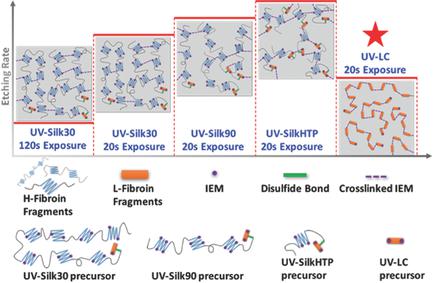Our official English website, www.x-mol.net, welcomes your
feedback! (Note: you will need to create a separate account there.)
Precise Protein Photolithography (P3): High Performance Biopatterning Using Silk Fibroin Light Chain as the Resist
Advanced Science ( IF 14.3 ) Pub Date : 2017-07-06 , DOI: 10.1002/advs.201700191 Wanpeng Liu 1 , Zhitao Zhou 2, 3 , Shaoqing Zhang 1 , Zhifeng Shi 4 , Justin Tabarini 1 , Woonsoo Lee 1 , Yeshun Zhang 5 , S N Gilbert Corder 6 , Xinxin Li 2, 3, 7 , Fei Dong 4 , Liang Cheng 4 , Mengkun Liu 6 , David L Kaplan 8 , Fiorenzo G Omenetto 8 , Guozheng Zhang 5 , Ying Mao 4 , Tiger H Tao 1, 2, 3, 7
Advanced Science ( IF 14.3 ) Pub Date : 2017-07-06 , DOI: 10.1002/advs.201700191 Wanpeng Liu 1 , Zhitao Zhou 2, 3 , Shaoqing Zhang 1 , Zhifeng Shi 4 , Justin Tabarini 1 , Woonsoo Lee 1 , Yeshun Zhang 5 , S N Gilbert Corder 6 , Xinxin Li 2, 3, 7 , Fei Dong 4 , Liang Cheng 4 , Mengkun Liu 6 , David L Kaplan 8 , Fiorenzo G Omenetto 8 , Guozheng Zhang 5 , Ying Mao 4 , Tiger H Tao 1, 2, 3, 7
Affiliation

|
Precise patterning of biomaterials has widespread applications, including drug release, degradable implants, tissue engineering, and regenerative medicine. Patterning of protein‐based microstructures using UV‐photolithography has been demonstrated using protein as the resist material. The Achilles heel of existing protein‐based biophotoresists is the inevitable wide molecular weight distribution during the protein extraction/regeneration process, hindering their practical uses in the semiconductor industry where reliability and repeatability are paramount. A wafer‐scale high resolution patterning of bio‐microstructures using well‐defined silk fibroin light chain as the resist material is presented showing unprecedent performances. The lithographic and etching performance of silk fibroin light chain resists are evaluated systematically and the underlying mechanisms are thoroughly discussed. The micropatterned silk structures are tested as cellular substrates for the successful spatial guidance of fetal neural stems cells seeded on the patterned substrates. The enhanced patterning resolution, the improved etch resistance, and the inherent biocompatibility of such protein‐based photoresist provide new opportunities in fabricating large scale biocompatible functional microstructures.
中文翻译:

精确蛋白质光刻(P3):使用丝素蛋白轻链作为抗蚀剂的高性能生物图案化
生物材料的精确图案化具有广泛的应用,包括药物释放、可降解植入物、组织工程和再生医学。使用蛋白质作为抗蚀剂材料,已经证明了使用紫外光刻法对基于蛋白质的微结构进行图案化。现有的基于蛋白质的生物光刻胶的致命弱点是在蛋白质提取/再生过程中不可避免地存在宽分子量分布,这阻碍了它们在可靠性和可重复性至关重要的半导体行业中的实际应用。使用明确的丝素蛋白轻链作为抗蚀剂材料的晶圆级高分辨率生物微结构图案显示出前所未有的性能。对丝素蛋白轻链抗蚀剂的光刻和蚀刻性能进行了系统评估,并深入讨论了其潜在机制。微图案丝结构作为细胞基质进行测试,以成功地引导接种在图案基质上的胎儿神经干细胞。这种基于蛋白质的光刻胶增强的图案分辨率、改进的抗蚀刻性和固有的生物相容性为制造大规模生物相容性功能微结构提供了新的机会。
更新日期:2017-07-06
中文翻译:

精确蛋白质光刻(P3):使用丝素蛋白轻链作为抗蚀剂的高性能生物图案化
生物材料的精确图案化具有广泛的应用,包括药物释放、可降解植入物、组织工程和再生医学。使用蛋白质作为抗蚀剂材料,已经证明了使用紫外光刻法对基于蛋白质的微结构进行图案化。现有的基于蛋白质的生物光刻胶的致命弱点是在蛋白质提取/再生过程中不可避免地存在宽分子量分布,这阻碍了它们在可靠性和可重复性至关重要的半导体行业中的实际应用。使用明确的丝素蛋白轻链作为抗蚀剂材料的晶圆级高分辨率生物微结构图案显示出前所未有的性能。对丝素蛋白轻链抗蚀剂的光刻和蚀刻性能进行了系统评估,并深入讨论了其潜在机制。微图案丝结构作为细胞基质进行测试,以成功地引导接种在图案基质上的胎儿神经干细胞。这种基于蛋白质的光刻胶增强的图案分辨率、改进的抗蚀刻性和固有的生物相容性为制造大规模生物相容性功能微结构提供了新的机会。











































 京公网安备 11010802027423号
京公网安备 11010802027423号